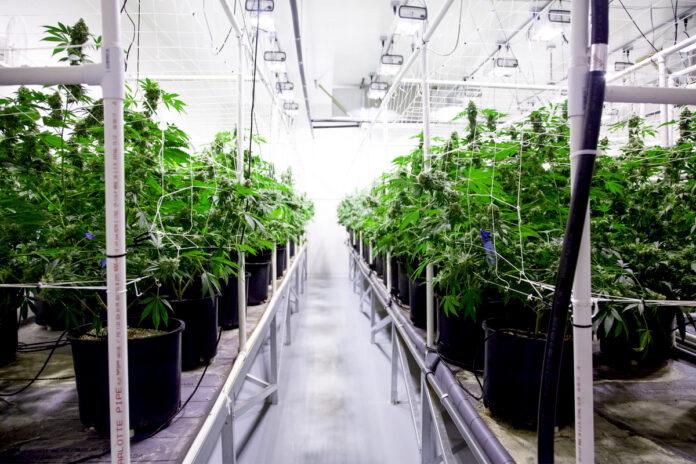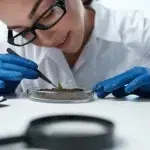Grow room hygiene is integral to a successful operation. Inadequate facility hygiene practices can present numerous issues, including pest infestations, plant pathogens, and mold growth, in addition to the need for more frequent maintenance. It can be hard to mitigate the damage from infested or compromised plants. Lower crop yields and increased costs associated with otherwise unnecessary soil and plant replacement are just the beginning. The additional facility maintenance also can slow down processes, impairing your ability to uphold customer commitments.
The answer is to maintain optimal facility hygiene from the start. By implementing good farming and production practices, including proper sanitization and sterilization regimes, grow room managers can help keep pests and undesirable microbes at bay. Regular attention to such details can help avoid unexpected costs and unpleasant maintenance surprises down the road.
Sanitization and sterilization are both important, but they’re not the same thing. Sanitization entails thoroughly cleaning a grow room; sterilization helps to remove potential hazards in their microbial state that may not be visible to the naked eye. Steps toward sanitizing a facility may include cleaning up dirt, washing down equipment, and wiping down containers, while sterilizing your facility could involve wiping down surfaces such as planters, floors, and tables using more stringent cleaning chemicals or procedures.
Sanitization should be a top priority for any indoor grow room, in the same way thorough cleaning is required of any operation that provides consumables, whether the facility is a packager of produce or a restaurant kitchen. Contamination from debris, dirt, spilled substances, and even excess water can present a health hazard for both the plants and workers occupying the space.
While a layperson may think nothing of a minor spill in a grow room, experienced managers understand any amount of excess moisture can tip the humidity balance in a controlled environment. Even a minor increase in relative humidity can increase the proliferation of fungi and moisture-loving pathogenic microbes that bring on plant rot. As every grower knows, mold spores can spread from plant to plant at an alarming rate.
When this occurs, quarantining the grow room, along with other prescribed measures, may be the only way out. Luckily, such scenarios often can be avoided by staying on top of good housekeeping, immediately mopping up spills, and carefully maintaining a consistent humidity level.
In addition to cleaning up spills, workers must be vigilant about debris, immediately removing spilled soil, dead leaves in and around plants, and other detritus. By depositing all dead plants, soil, and old roots at a sufficient distance from the grow room, managers can mitigate the risk of biological contamination. These simple common-sense measures go a long way in staving off pests and diseases that can wipe out previously healthy plants.
Due to time and economic pressures, indoor farmers may be tempted to deal with signs of plant rot or mold on a short-term basis, without taking time to thoroughly sanitize their facility to prevent future or ongoing issues. However, once an infestation or contamination has started, it can be almost impossible to eradicate without implementing facility-wide processes.
For thoughtful managers committed to minimizing infestation and pestilence risks, sterilization can go a long way. Regularly sterilizing a grow facility can help eliminate and prevent the growth of fungi, spores, bacteria, and viruses. Several sterilization methods are available, including chemical cleaners and heat.
Sanitization must be performed daily, but sterilization may be performed less frequently. While use of cleaning solutions such as bleach and other corrosive chemicals can be extremely helpful, overexposure can damage sensitive crops. Experts recommend sterilization take place immediately after harvesting to avoid harming plants.
Air sanitization systems also can be beneficial, as they help clean, and in some cases sterilize, the grow room air to minimize potential contaminants.
In addition to ongoing daily sanitization and occasional sterilization, grow managers can help protect their facilities by taking the following steps.
Pressure-wash and vacuum
To maintain a truly clean grow room facility, periodic maintenance is required. That means completely emptying out the space for a good scrub-down. While larger equipment can remain in place, managers should require every pot and plant and all organic material from leaves to soil be removed. As part of the preparation, there also should be no extraneous tools, chemicals, water sources, hoses, buckets, or puddles left in the space. Once the room is completely empty of everything that can be moved, the next steps are to pressure wash and vacuum.
Industrial shop vacuums and construction-grade pressure washers are the most reliable for such facility-wide projects. When selecting a new vacuum, for best results opt for higher-functioning wet-and-dry shop vacs. Dry shop vacs utilize dust filters that can become muddy when wet, minimizing airflow and performance.
Having a good quality pressure washer is a must for any grow room. Small electric pressure washers are lightweight and great for smaller square footages or as backup units. Heavy-duty, gas-powered pressure washers come with a longer lifespan, additional power, and the ability to wash down larger spaces efficiently.
When using a high-powered pressure washer, it’s important to test floor and wall surfaces for the effects of lighter and heavier streams to avoid damage. Wearing safety glasses in lieu of goggles—which tend to fog up—along with hearing protection also makes sense.
Once the grow room is completely empty, a pressure washer can be used to thoroughly clean surfaces. Be sure to direct the stream along cracks and crevices to help eradicate tiny, hard-to-spot visitors such as spider mites. Start at the tops of walls, moving down to tables, benches and, eventually, the floor. Direct all dirty water, soil, and debris toward a removable floor drain catch or trap. Be sure to dispose of the trap material afterward and consider sterilizing the unit before replacing it to help mitigate any pathogens or contaminants.
Install chemical-resistant coatings
Chemical-resistant floor and wall coating systems play an important role in any comprehensive grow room sanitization and sterilization program. High-strength and virtually seamless, these fluid-applied, USDA- and FDA-compliant surface coverings can save managers from having to battle facility hygiene issues and environmental concerns associated with bare concrete and unprotected walls, such as:
•Permeability: Unprotected concrete, concrete wall block, and wallboard are porous and can absorb liquids. Water, moisture, and other substances can and do become entrapped in their undefended surface pores, offering fungi and mold a perfect breeding environment. Chemical-resistant coatings are the most economical way to prevent this.
•Seams and grout lines: Any surface with open joints, grout lines, cracks, or fissures provides undesirable microbes and critters great hiding places in which to proliferate. Industrial resinous coatings can be used to fill and bridge surface breaches to create smooth, cleanable surfaces.
•Toxic hazards: Pesticides, fertilizers, and other chemicals used in many grow rooms can be particularly toxic for the surrounding natural environment. Chemical-resistant floor coatings can prevent spilled toxins from leaching through porous concrete. The splashed substances remain on the surface where they can be removed.
•Surface deterioration: Unprotected concrete floor slabs, concrete wall block, and wallboard can begin to break down quickly in grow room conditions, given the high moisture and chemical substances in use. Chemical-resistant coatings help to extend the usable life of concrete floors and wall substrates, thereby helping to safeguard facility investment.
For grow rooms intent on proper facility hygiene, installing high-quality floor and wall coatings such as resinous epoxy and urethane systems is a smart, value-based choice. Manufacturers that specialize in developing solutions for these facilities can supply coatings customized for high moisture tolerance and improved slip-resistance, as well as with additional anti-microbial properties. These coatings also can be used to correct floor slope so spilled water flows naturally toward a floor drain as opposed to puddling.
With high-performance floor and wall coatings, proper grow room maintenance can be performed more consistently. Using pressure washers and cleaning solutions can be easier and safer.
Without a doubt, good grow room hygiene pays off. It allows more plants to flourish and achieve harvest, resulting in increased yields and better return on investment. Through the integration of sanitization and sterilization processes along with specialized grow room floor and wall protection, facility managers can more effectively protect cannabis operations over the long term.













[…] run the risk of burning plants, which can be highly detrimental to your marijuana grow. When heat is a factor in the grow room, it’s important to pay far more attention to the distance between each plant and the incandescent […]
[…] and reliable—something the U.S. should note in preparation for the future. Such standards include cleanroom design to minimize the risk of contamination and heating, ventilation, and air-conditioning design to […]